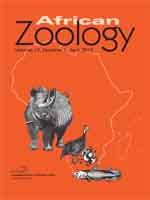Many studies have examined the effect of caudal autotomy on speed and behaviour of lizards escaping over horizontal surfaces, but there have been few studies on lizards escaping over vertical surfaces and, in particular, species that jump between surfaces. We examined jumping by the Cape dwarf gecko (Lygodactylus capensis) in terms of individuals' varying states of tail autotomy and regeneration. Although longer jumps were less likely to be successful (i.e. the animal would not successfully grip the surface and fell to the ground), there was no difference in the distance over which animals with full and partial tails would attempt to jump. Both recently autotomized individuals and individuals with intact tails successfully jumped up to nine times their body length (snout—vent length). The jumping ability of L. capensis was therefore clearly not negatively impaired by tail loss, presumably because the geckos are using their hind legs to propel their jump. Their tails may, however, be important to control their landing as well as their locomotion on vertical surfaces. The high observed frequency of tail loss, coupled with rapid and complete regeneration (including the scansorial tail tip), suggests that caudal autotomy is an important survival tactic in this species.
How to translate text using browser tools
1 April 2012
Autotomy, Tail Regeneration and Jumping ability in Cape Dwarf Geckos (Lygodactylus capensis) (Gekkonidae)
Patricia A. Fleming,
Philip W. Bateman
ACCESS THE FULL ARTICLE

African Zoology
Vol. 47 • No. 1
April 2012
Vol. 47 • No. 1
April 2012
caudal autotomy
defence
escape behaviour
leaping
lizard
tail loss




